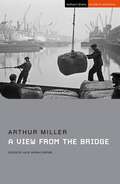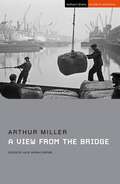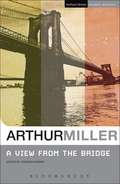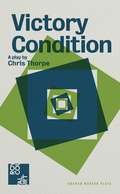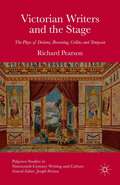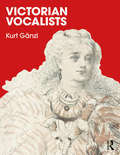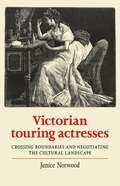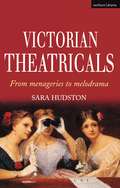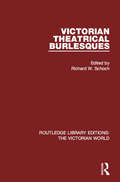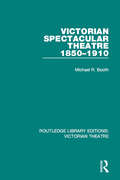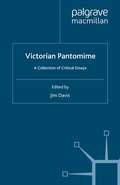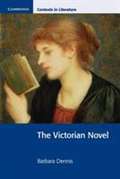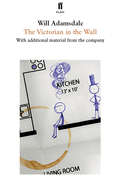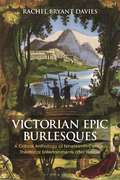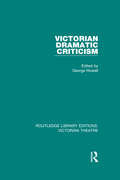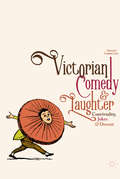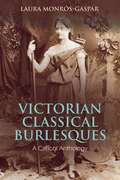- Table View
- List View
A View from the Bridge (Student Editions)
by Arthur MillerThe law is nature. The law is only a word for what has a right to happen. When the law is wrong it's because it's unnatural, but in this case it is natural and a river will drown you if you buck it now. Let her go. And bless her.Set among Italian-Americans on the Brooklyn waterfront, A View from the Bridge is the story of longshoreman Eddie Carbone. When his wife's cousins arrive as illegal immigrants from Italy, he is honoured to take them into his house. But when his niece begins to fall in love with one of them, Eddie grows increasingly suspicious, eventually precipitating his violation of the moral and cultural codes of his community and leading to the play's tragic finale. With its examination of the themes of sexuality, responsibility, betrayal and vengeance, A View from the Bridge is Miller at his best and a modern classic.This new edition includes an introduction by Julie Vatain-Corfdir that explores the play's production history as well as the dramatic, thematic, and academic debates that surround it; a must-have resource for any student exploring A View from the Bridge.
A View from the Bridge (Student Editions)
by Arthur MillerThe law is nature. The law is only a word for what has a right to happen. When the law is wrong it's because it's unnatural, but in this case it is natural and a river will drown you if you buck it now. Let her go. And bless her.Set among Italian-Americans on the Brooklyn waterfront, A View from the Bridge is the story of longshoreman Eddie Carbone. When his wife's cousins arrive as illegal immigrants from Italy, he is honoured to take them into his house. But when his niece begins to fall in love with one of them, Eddie grows increasingly suspicious, eventually precipitating his violation of the moral and cultural codes of his community and leading to the play's tragic finale. With its examination of the themes of sexuality, responsibility, betrayal and vengeance, A View from the Bridge is Miller at his best and a modern classic.This new edition includes an introduction by Julie Vatain-Corfdir that explores the play's production history as well as the dramatic, thematic, and academic debates that surround it; a must-have resource for any student exploring A View from the Bridge.
A View from the Bridge
by Arthur Miller Steve MarinoThis Student Edition of A View from the Bridge is perfect for students of literature and drama and offers an unrivalled guide to Miller's play. It features an extensive introduction by Steve Marino which includes: a chronology of Miller's life and times; a summary of the plot and commentary on the characters, themes, language, context and production history of the play. Together with over twenty questions for further study and detailed notes on words and phrases from the text, this is the definitive edition of the play. Set among Italian-Americans on the Brooklyn waterfront, A View from the Bridge is the story of longshoreman Eddie Carbone. When his wife's cousins arrive as illegal immigrants from Italy, he is honoured to take them into his house. But when his niece begins to fall in love with one of them Eddie grows increasingly suspicious, eventually precipitating his violation of the moral and cultural codes of his community and leading to the play's tragic finale. With its examination of the themes of sexuality, responsibility, betrayal and vengeance, the play is vintage Miller and a modern classic.
A View from the Bridge (York Notes)
by Arthur Miller Steve MarinoThis Student Edition of A View from the Bridge is perfect for students of literature and drama and offers an unrivalled guide to Miller's play. It features an extensive introduction by Steve Marino which includes: a chronology of Miller's life and times; a summary of the plot and commentary on the characters, themes, language, context and production history of the play. Together with over twenty questions for further study and detailed notes on words and phrases from the text, this is the definitive edition of the play. Set among Italian-Americans on the Brooklyn waterfront, A View from the Bridge is the story of longshoreman Eddie Carbone. When his wife's cousins arrive as illegal immigrants from Italy, he is honoured to take them into his house. But when his niece begins to fall in love with one of them Eddie grows increasingly suspicious, eventually precipitating his violation of the moral and cultural codes of his community and leading to the play's tragic finale. With its examination of the themes of sexuality, responsibility, betrayal and vengeance, the play is vintage Miller and a modern classic.
Victory Condition (Oberon Modern Plays)
by Chris Thorpe'A thousand people are taking a sip of coffee within the city limits of Johannesburg, each unaware of the other doing it, each one necessarily thinking they are the only one.An attempt to get to grips with the fact that everything happens at once. And to see if there’s anything we can do about it.'Find the connection between where you are and where I am. Open up the space between us and do something.
Victorian Writers and the Stage: The Plays of Dickens, Browning, Collins and Tennyson (Palgrave Studies in Nineteenth-Century Writing and Culture)
by R. PearsonThis book examines the dramatic work of Dickens, Browning, Collins, and Tennyson, their interaction with the theatrical world, and their attempts to develop their reputations as playwrights. These major Victorian writers each authored several professional plays, but why has their achievement been overlooked?
Victorian Vocalists
by Kurt GanzlVictorian Vocalists is a masterful and entertaining collection of 100 biographies of mid- to late-19th-century singers and stars. Kurt Gänzl paints a vivid picture of the Victorian operatic and concert world, revealing the backgrounds, journeys, successes, failures and misdemeanours of these singers. This volume is not only an outstanding reference work for anyone interested in vocalists of the era, but also a compelling, meticulously researched picture of life in the vast shark tank that was Victorian music.
Victorian Vocalists
by Kurt GanzlVictorian Vocalists is a masterful and entertaining collection of 100 biographies of mid- to late-19th-century singers and stars. Kurt Gänzl paints a vivid picture of the Victorian operatic and concert world, revealing the backgrounds, journeys, successes, failures and misdemeanours of these singers. This volume is not only an outstanding reference work for anyone interested in vocalists of the era, but also a compelling, meticulously researched picture of life in the vast shark tank that was Victorian music.
Victorian touring actresses: Crossing boundaries and negotiating the cultural landscape (Women, Theatre and Performance)
by Janice NorwoodVictorian touring actresses brings new attention to women’s experience of working in nineteenth-century theatre by focusing on a diverse group of largely forgotten ‘mid-tier’ performers, rather than the usual celebrity figures. It examines how actresses responded to changing political, economic and social circumstances and how the women were themselves agents of change. Their histories reveal dynamic patterns of activity within the theatrical industry and expose its relationship to wider Victorian culture. With an innovative organisation mimicking the stages of an actress’s life and career, the volume draws on new archival research and plentiful illustrations to examine the challenges and opportunities facing the women as they toured both within the UK and further afield in North America and Australasia. It will appeal to students and researchers in theatre and performance history, Victorian studies, gender studies and transatlantic studies.
Victorian touring actresses: Crossing boundaries and negotiating the cultural landscape (Women, Theatre and Performance)
by Janice NorwoodVictorian touring actresses brings new attention to women’s experience of working in nineteenth-century theatre by focusing on a diverse group of largely forgotten ‘mid-tier’ performers, rather than the usual celebrity figures. It examines how actresses responded to changing political, economic and social circumstances and how the women were themselves agents of change. Their histories reveal dynamic patterns of activity within the theatrical industry and expose its relationship to wider Victorian culture. With an innovative organisation mimicking the stages of an actress’s life and career, the volume draws on new archival research and plentiful illustrations to examine the challenges and opportunities facing the women as they toured both within the UK and further afield in North America and Australasia. It will appeal to students and researchers in theatre and performance history, Victorian studies, gender studies and transatlantic studies.
Victorian Theatricals (Diaries, Letters and Essays)
by Sara HudstonA captivating study of the plays, literature and writings about private and public theatrical spectacle during the Victorian AgeBy the 1890s the British theatre had transformed itself into a world where spectacles and public shows were aimed at the widest audience possible. The theatre had become big business. This anthology brings together a variety of plays and prose which sets this phenomenon in perspective and traces the development of Victorian theatricals from private home events in the late-Georgian period to full-scale Gilbert and Sullivan operettas in the 1890s. The section 'Theatrical Behaviour' looks at the world of the audience and includes extracts from Jane Austen's novel Mansfield Park; Thackeray's Vanity Fair; an anonymous playlet called Acting Proverbs; and an extract from Marie Corelli's novel Sorrows of Satan. In 'Fun and Freaks' we explore the world of popular, sensationalist entertainment through the eyes of Dickens, Thomas Hardy, Dion Boucicault and others. In the final section, 'Society', we have the scripts for four principal melodramas and serious plays of the age: The Factory Lad by John Walker; Society by T.W. Robertson; The Mikado by W.S. Gilbert and The Second Mrs Tanqueray by Arthur Wing Pinero.
Victorian Theatricals (Diaries, Letters and Essays)
by Sara HudstonA captivating study of the plays, literature and writings about private and public theatrical spectacle during the Victorian AgeBy the 1890s the British theatre had transformed itself into a world where spectacles and public shows were aimed at the widest audience possible. The theatre had become big business. This anthology brings together a variety of plays and prose which sets this phenomenon in perspective and traces the development of Victorian theatricals from private home events in the late-Georgian period to full-scale Gilbert and Sullivan operettas in the 1890s. The section 'Theatrical Behaviour' looks at the world of the audience and includes extracts from Jane Austen's novel Mansfield Park; Thackeray's Vanity Fair; an anonymous playlet called Acting Proverbs; and an extract from Marie Corelli's novel Sorrows of Satan. In 'Fun and Freaks' we explore the world of popular, sensationalist entertainment through the eyes of Dickens, Thomas Hardy, Dion Boucicault and others. In the final section, 'Society', we have the scripts for four principal melodramas and serious plays of the age: The Factory Lad by John Walker; Society by T.W. Robertson; The Mikado by W.S. Gilbert and The Second Mrs Tanqueray by Arthur Wing Pinero.
Victorian Theatrical Burlesques (Routledge Library Editions: The Victorian World)
by Richard SchochFirst published in 2003. Wildly popular in their own day, Victorian burlesques are now little read, scarcely studied, and never performed. Giving long overdue emphasis to an unjustly neglected theatrical tradition, this critical edition - the first to focus on Victorian burlesques of Victorian plays - represents a valuable scholarly tool for students and scholars of modern drama, theatre history, and nineteenth-century popular culture. Victorian Theatrical Burlesques includes a 'state-of-the-art' introduction which provides a general overview of theatrical burlesques in the Victorian era, emphasising performance history. Sustained reference is made to burlesques other than those presented in the anthology. Through its general introduction, prefaces and annotations to individual plays, checklist of burlesque plays, and bibliography, the unique volume allows both specialist and non-specialist readers to see Victorian burlesques as a rich historical record of shifting attitudes toward drama and the theatre.
Victorian Theatrical Burlesques (Routledge Library Editions: The Victorian World)
by Richard W. SchochFirst published in 2003. Wildly popular in their own day, Victorian burlesques are now little read, scarcely studied, and never performed. Giving long overdue emphasis to an unjustly neglected theatrical tradition, this critical edition - the first to focus on Victorian burlesques of Victorian plays - represents a valuable scholarly tool for students and scholars of modern drama, theatre history, and nineteenth-century popular culture. Victorian Theatrical Burlesques includes a 'state-of-the-art' introduction which provides a general overview of theatrical burlesques in the Victorian era, emphasising performance history. Sustained reference is made to burlesques other than those presented in the anthology. Through its general introduction, prefaces and annotations to individual plays, checklist of burlesque plays, and bibliography, the unique volume allows both specialist and non-specialist readers to see Victorian burlesques as a rich historical record of shifting attitudes toward drama and the theatre.
Victorian Spectacular Theatre 1850-1910 (Routledge Library Editions: Victorian Theatre)
by Michael R. BoothOriginally published in 1981. This study concentrates on one aspect of Victorian theatre production in the second half of the nineteenth century – the spectacular, which came to dominate certain kinds of production during that period. A remarkably consistent style, it was used for a variety of dramatic forms, although surrounded by critical controversy. The book considers the theories and practice of spectacle production as well as the cultural and artistic movements that created the favourable conditions in which spectacle could dominate such large areas of theatre for so many years. It also discusses the growth of spectacle and the taste of the public for it, examining the influence of painting, archaeology, history, and the trend towards realism in stage production. An explanation of the working of spectacle in Shakespeare, pantomime and melodrama is followed by detailed reconstructions of the spectacle productions of Irving’s Faust and Beerbohm Tree’s King Henry VIII.
Victorian Spectacular Theatre 1850-1910 (Routledge Library Editions: Victorian Theatre)
by Michael R. BoothOriginally published in 1981. This study concentrates on one aspect of Victorian theatre production in the second half of the nineteenth century – the spectacular, which came to dominate certain kinds of production during that period. A remarkably consistent style, it was used for a variety of dramatic forms, although surrounded by critical controversy. The book considers the theories and practice of spectacle production as well as the cultural and artistic movements that created the favourable conditions in which spectacle could dominate such large areas of theatre for so many years. It also discusses the growth of spectacle and the taste of the public for it, examining the influence of painting, archaeology, history, and the trend towards realism in stage production. An explanation of the working of spectacle in Shakespeare, pantomime and melodrama is followed by detailed reconstructions of the spectacle productions of Irving’s Faust and Beerbohm Tree’s King Henry VIII.
Victorian Pantomime: A Collection of Critical Essays
by Jim DavisFeaturing contributions by new and established nineteenth-century theatre scholars, this collection of critical essays is the first of its kind devoted solely to Victorian pantomime. It takes us through the various manifestations of British pantomime in the Victorian period and its ambivalent relationship with Victorian values.
The Victorian Novel (PDF)
by Barbara Dennis Adrian BarlowCritical introductions to a range of literary topics and genres. This book invites readers to reflect on the whole phenomenon of the Victorian novel and its role in dissecting and informing the society which produced it. The reasons for the growth of the novel and its spectacular success is also examined and discussed. Texts and extracts from a selection of Victorian novels and essays, including some material that readers will be unfamiliar with, help to provide a broader understanding of the range of Victorian fiction. Authors include: Thomas Carlyle, Charles Dickens, George Eliot, Anthony Trollope and Max Beerbohm.
The Victorian in the Wall
by Will AdamsdaleLatte-land. Power-prams, Grand Design knock-throughs, organic everything. A work-shy writer discovers a Victorian man living in the wall of his flat. Everyone's pretty surprised. Adjustments need to be made. Can the strange visitor unlock his hopeless career? His flagging relationship? A story buried in these walls for over a century? (Doubt it. Maybe. Yes.) Contains jokes, songs, banging on recycling boxes, a talking fridge. Will Adamsdale's The Victorian in the Wall premiered at the Royal Court Theatre, London, in May 2013.
Victorian Epic Burlesques: A Critical Anthology of Nineteenth-Century Theatrical Entertainments after Homer (Bloomsbury Studies in Classical Reception)
by Rachel Bryant DaviesThis anthology presents annotated scripts of four major burlesques by key playwrights: Melodrama Mad! or, the Siege of Troy by Thomas John Dibdin (1819); Telemachus; or, the Island of Calypso by J.R. Planché (1834); The Iliad; or, the Siege of Troy by Robert Brough (1858) and Ulysses; or the Ironclad Warriors and the Little Tug of War by F.C. Burnand (1865). Beloved legend, archaeological riddle and educational staple: Homer's epic tales of the Trojan War and its aftermath were vividly reimagined in nineteenth-century Britain. Classical burlesques-exceptionally successful theatrical entertainments-continually mined the Iliad and Odyssey to lucrative comic effect. Burlesques combined song, dance and slapstick comedy with an eclectic kaleidoscope of topical allusions. From namedropping boxing legends to recasting Shakespearean combats, epic adaptations overflow with satirical commentary on politics, cultural highlights and everyday current affairs. In uncovering Homer's irreverently playful afterlife, this selection showcases burlesque's development and wide appeal. The critical introduction analyses how these plays contested the accessibility of classical antiquity and dramatic performance. Textual and literary annotations, with contemporary illustrations, illuminate the juxtaposed sources to establish these repackaged epics as indispensable tools for unlocking nineteenth-century social, cultural and political history. Resources for further study are available online.
Victorian Epic Burlesques: A Critical Anthology of Nineteenth-Century Theatrical Entertainments after Homer (Bloomsbury Studies in Classical Reception)
by Rachel Bryant DaviesThis anthology presents annotated scripts of four major burlesques by key playwrights: Melodrama Mad! or, the Siege of Troy by Thomas John Dibdin (1819); Telemachus; or, the Island of Calypso by J.R. Planché (1834); The Iliad; or, the Siege of Troy by Robert Brough (1858) and Ulysses; or the Ironclad Warriors and the Little Tug of War by F.C. Burnand (1865). Beloved legend, archaeological riddle and educational staple: Homer's epic tales of the Trojan War and its aftermath were vividly reimagined in nineteenth-century Britain. Classical burlesques-exceptionally successful theatrical entertainments-continually mined the Iliad and Odyssey to lucrative comic effect. Burlesques combined song, dance and slapstick comedy with an eclectic kaleidoscope of topical allusions. From namedropping boxing legends to recasting Shakespearean combats, epic adaptations overflow with satirical commentary on politics, cultural highlights and everyday current affairs. In uncovering Homer's irreverently playful afterlife, this selection showcases burlesque's development and wide appeal. The critical introduction analyses how these plays contested the accessibility of classical antiquity and dramatic performance. Textual and literary annotations, with contemporary illustrations, illuminate the juxtaposed sources to establish these repackaged epics as indispensable tools for unlocking nineteenth-century social, cultural and political history. Resources for further study are available online.
Victorian Dramatic Criticism (Routledge Library Editions: Victorian Theatre)
by George RowellOriginally published in 1971. The Victorian Age was one of popular theatre and increasingly popular journalism. One manifestation of this journalism was the emergence of the dramatic critic from the anonymity and brevity which had previously characterized periodical treatment of the theatre. If Victorian theatre is regarded as existing essentially thirty years before Victoria acceded and continuing until the outbreak of war in 1914, the names of Lamb, Leigh Hunt and Hazlitt at one end, and of Beerbohm and MacCarthy at the other, can be added to a list that includes Lewes, James, Archer, Walkley, Shaw and Montague. All these writers, and others less famous, are represented in this selection. By selecting the articles on the basis of the play in performance, rather than the play as literature, and by arranging them according to various aspects of the theatrical process, this book builds up a skilful and lively picture of the contemporary theatre at work, in the words of its leading commentators. The anthology successfully conveys the qualities of abundance and vitality to characteristic of Victorian theatre.
Victorian Dramatic Criticism (Routledge Library Editions: Victorian Theatre)
by George RowellOriginally published in 1971. The Victorian Age was one of popular theatre and increasingly popular journalism. One manifestation of this journalism was the emergence of the dramatic critic from the anonymity and brevity which had previously characterized periodical treatment of the theatre. If Victorian theatre is regarded as existing essentially thirty years before Victoria acceded and continuing until the outbreak of war in 1914, the names of Lamb, Leigh Hunt and Hazlitt at one end, and of Beerbohm and MacCarthy at the other, can be added to a list that includes Lewes, James, Archer, Walkley, Shaw and Montague. All these writers, and others less famous, are represented in this selection. By selecting the articles on the basis of the play in performance, rather than the play as literature, and by arranging them according to various aspects of the theatrical process, this book builds up a skilful and lively picture of the contemporary theatre at work, in the words of its leading commentators. The anthology successfully conveys the qualities of abundance and vitality to characteristic of Victorian theatre.
Victorian Comedy and Laughter: Conviviality, Jokes and Dissent
by Louise LeeThis innovative collection of essays is the first to situate comedy and laughter as central rather than peripheral to nineteenth century life. Victorian Comedy and Laughter: Conviviality,Jokes and Dissent offers new readings of the works of Charles Dickens, Edward Lear,George Eliot, George Gissing, Barry Pain and Oscar Wilde, alongside discussions of much-loved Victorian comics like Little Tich, Jenny Hill, Bessie Bellwood and Thomas Lawrence. Tracing three consecutive and interlocking moods in the period, all of the contributors engage with the crucial critical question of how laughter and comedy shaped Victorian subjectivity and aesthetic form. Malcolm Andrews, Jonathan Buckmaster and Peter Swaab explore the dream of print culture togetherness that is conviviality, while Bob Nicholson, Louise Lee, Ann Featherstone,Louise Wingrove and Oliver Double discuss the rise-on-rise of the Victorian joke — both on the page and the stage — while Peter Jones, Jonathan Wild and Matthew Kaiser consider the impassioned debates concerning old and new forms of laughter that took place at the end of the century.
Victorian Classical Burlesques: A Critical Anthology (Bloomsbury Studies in Classical Reception)
by Laura Monros-GasparThe Victorian classical burlesque was a popular theatrical genre of the mid-19th century. It parodied ancient tragedies with music, melodrama, pastiche, merciless satire and gender reversal. Immensely popular in its day, the genre was also intensely metatheatrical and carries significance for reception studies, the role and perception of women in Victorian society and the culture of artistic censorship.This anthology contains the annotated text of four major classical burlesques: Antigone Travestie (1845) by Edward L. Blanchard, Medea; or, the Best of Mothers with a Brute of a Husband (1856) by Robert Brough, Alcestis; the Original Strong-Minded Woman (1850) and Electra in a New Electric Light (1859) by Francis Talfourd. The cultural and textual annotations highlight the changes made to the scripts from the manuscripts sent to the Lord Chamberlain's office and, by explaining the topical allusions and satire, elucidate elements of the burlesques' popular cultural milieu.An in-depth critical introduction discusses the historical contexts of the plays' premieres and unveils the cultural processes behind the reception of the myths and original tragedies. As the burlesques combined spectacular effects with allusions to contemporary affairs, ambivalent and provocative attitudes to women, the plays represent an essential tool for reading the social history of the era.
